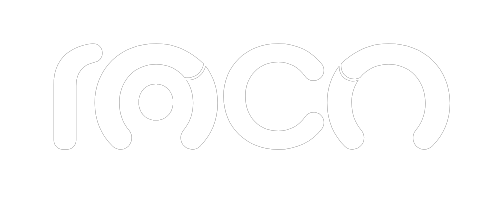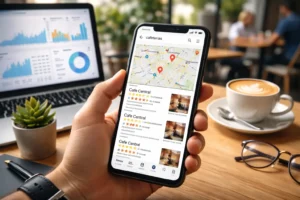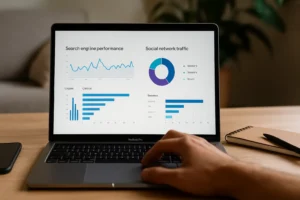Images are a fundamental pillar in digital marketing. From Google Ads campaigns and SEO strategies to creating attractive websites, its importance is undeniable. Keeping your audience engaged is essential, and choosing the right image types can make all the difference.
Have you wondered which are the most effective image formats for your needs? In this article, you will discover the various image types and how each can influence the performance of your online content. Keep reading and optimize your visual strategy!
Image Types: Which Are the Most Common?
JPEG (Joint Photographic Experts Group)
The JPEG format is one of the oldest and most popular formats, ideal for photographs and complex graphics with many colors. Its main advantage is the ability to compress images to reduce file size without sacrificing too much quality. This speeds up the loading of web pages, which is crucial for maintaining a good user experience.
Also, another thing to keep in mind is that the JPEG format is widely supported by most browsers and devices, making it a versatile option for various uses.
PNG (Portable Network Graphics)
The PNG format is widely used for graphics with transparent backgrounds and for images with text. Transparency is a very useful feature for graphic designers and web developers who need to overlay images without compromising aesthetics. Additionally, PNG offers lossless compression, meaning the image quality remains intact. This makes it ideal for logos, detailed graphics, and screenshots where clarity is essential.
GIF (Graphics Interchange Format)
GIF files are known for their ability to support animated images with palettes of up to 256 colors. Although not ideal for photographs due to their color limitation, GIFs are great for simple graphics and short animations. Their animation capacity makes them popular in social networks and email marketing campaigns, where they can add a dynamic and attractive touch to visual messages.
SVG (Scalable Vector Graphics)
The SVG format is not really a raster image format like the previous ones, but rather a vector graphics format that can be scaled indefinitely without losing quality. This makes it perfect for logos, icons and other design elements that require high flexibility and resolution. SVGs are particularly useful in responsive web design, where images must adapt to different screen sizes without loss of quality.
Less Known Image Types
TIFF (Tagged Image File Format)
TIFF is a type of image file known for its high quality and its use in professional photo editing. It supports a wide color gamut and multiple layers, making it ideal for storage and editing in advanced design software. However, its larger file size may be a drawback for web use, although it is excellent for high-quality prints and digital files.
WEBP (Web Picture Format)
Developed by Google, the WEBP format is gaining popularity due to its ability to offer lossy and lossless compression. One of its main advantages is the significant reduction in file size compared to other formats, without sacrificing quality. This makes it an excellent option to improve the loading speed of web pages, contributing to a better user experience and more efficient SEO optimization.
BMP (Bitmap)
The BMP format is one of the oldest and offers uncompressed images, resulting in enormously large files. Its use has been greatly reduced, but it can still be useful for certain types of high-resolution graphics. BMPs are most common in specific applications where maximum quality is necessary and file size is not a limitation.
Optimize your images for greater digital impact
Do you know which image format is best for your website or campaign? We help you choose and use the image types that best suit your needs, improving loading speed, visual quality, and user experience.
Considerations for Choosing the Right Image Types
Load Speed Factor
One of the most important aspects to consider when choosing between types of image formats is page loading speed. Optimizing image weight is crucial to improving site performance and user experience. As we mentioned above, JPEG and WEBP formats are excellent options when looking for a balance between quality and file size.
Image quality
Quality is another fundamental factor. For complex photographs and graphics, formats such as JPEG and PNG are ideal. For scalable design elements, SVG is the best option. Note that lossless compression is preferable when quality is of utmost importance, such as in graphic design and professional photography.
Compatibility and Usage
Each image file type has its own advantages and disadvantages in terms of compatibility and usage. For example, JPEG and PNG formats are supported by almost all browsers and social media platforms, while formats like SVG and WEBP may have limitations in certain cases. Make sure you choose a format that is widely compatible with the devices and platforms where your content will be displayed.
Transparency and Layers
If your project requires transparency, then the PNG format is suitable. For images that need to be edited on multiple layers, TIFF is a solid option. Always consider the specific needs of your project before deciding on a format.
Tips to Optimize Images for SEO
Use Descriptive Names for Your Files
Using descriptive file names is a basic but effective strategy to improve your SEO. For example, instead of naming a file “IMG_1234.jpg,” use something like “digital-seo-marketing-strategy.jpg.” This helps search engines understand the content of your images and improve their indexing.
Alt Attributes and Titles
Don't forget to add Alt attributes and titles to your images. These not only help with the accessibility of your site but can also improve your search engine rankings. Alt attributes should concisely and accurately describe the content of the image, while titles can provide useful additional information.
Compression Tools
Tools like TinyPNG or ImageOptim can help you reduce the size of your images without losing quality, making your website load faster. Image compression is essential to maintain fast loading times and improve user experience.
Modern Formats
Adopt modern formats like WEBP to take advantage of their advanced compression capabilities. Many CMS and digital marketing platforms are starting to support this format, making it easier to implement. Using modern formats can significantly improve the performance of your website.
Exploring the different types of image files and how they can affect your content strategy may seem like a complex task, but the payoff in terms of site performance and user engagement is undeniable. By mastering the use of proper formats, you not only optimize your content for SEO but also offer a better experience to your audience.
Optimize your On-Page SEO with the Experts
Success in digital marketing not only depends on having optimized images, but also on having effective On-Page SEO. If you are looking to improve your website's ranking and attract quality organic traffic, our team of experts is here to help. We offer personalized strategies that guarantee long-lasting and effective results.
Click the button and discover how we can transform your On-Page SEO strategy.





